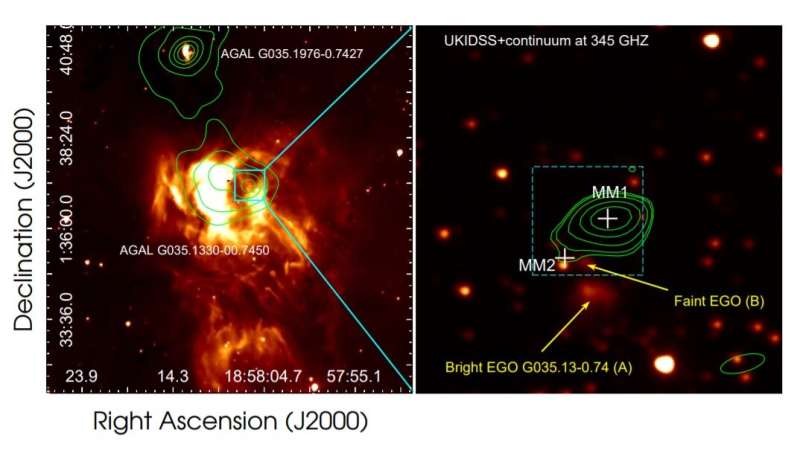January 4, 2022 report
Study explores the substructure of massive clump AGAL35

Using the Atacama Large Millimeter Array (ALMA), Argentinian astronomers have investigated a massive molecular clump known as AGAL35 (or AGAL G035.1330−00.7450). Results of the study, published December 27 on the arXiv preprint server, could advance the understanding of the process of star formation.
Observations show that high-mass stars form due to the fragmentation of massive molecular clumps. Such clumps may collapse under self-gravity and fragment into multiple cores. However, it is still debated whether massive star formation is due to an individual monolithic core collapse, or to a global hierarchical collapse of a molecular clump.
At a distance of about 6,850 light years away from the Earth, AGAL35 is an infrared-quiet, massive molecular clump. The object experiences limited fragmentation, and hence, it is perceived as an excellent source to study the early massive star-forming processes.
Therefore, a team of astronomers led by Martin E. Ortega of the University of Buenos Aires in Argentina, investigated the fragmentation and the kinematics of the molecular gas of the massive clump AGAL35 in order to unveil its internal structure. For this purpose they used high-angular resolution data from ALMA.
"Using millimeter observations of continuum and molecular lines obtained from the Atacama Large Millimeter Array database at Bands 6 and 7, we study the substructure of the source AGAL35. The angular resolution of the data at Band 7 is about 0′′.7, which allows us to resolve structures of about 0.007 pc (∼1,500 AU)," the researchers wrote in the paper.
The study found that AGAL35 harbors four infrared-quiet dust cores (designated C1, C2, C3 and C4) with masses below 3 solar masses, therefore less massive than previously thought. C1 and C2 exhibit acetonitrile (CH3CN) emission, while C3 and C4 showcase well collimated, young, and low-mass molecular outflows related to molecular hydrogen emission-line objects.
It was found that C1 and C2 have temperatures of about 180 and 100 K, respectively. When it comes to their mass, the astronomers estimate that C1 is approximately 40 percent more massive than the sun, while C2 has a mass at a level of around 0.9 solar masses. According to the researchers, the properties of these two sources suggest that they are hot corinos—warm, dense inner regions of envelopes of young stellar objects (YSOs) with complex organic molecules.
Given that the four identified cores have relatively low mass, the authors of the paper noted that the only possibility when high-mass stars could form in such massive molecular clump like AGAL35 would be through the competitive accretion mechanism.
"In this regard, the filamentary structure exhibited by the CN emission might be tracing the gas falling towards the cores, which would be evidence of a competitive accretion scenario," the researchers concluded.
More information: M. E. Ortega, A. Marinelli, N. L. Isequilla, S. Paron, Unveiling the substructure of the massive clump AGAL G035.1330−00.7450. arXiv:2112.13735v1 [astro-ph.GA], arxiv.org/abs/2112.13735
© 2022 Science X Network





















